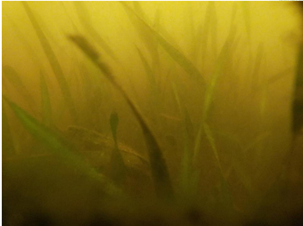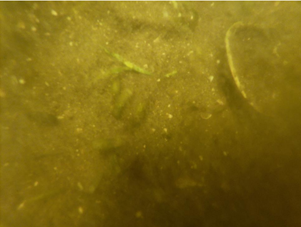 It’s been over three years since AAF started planting Vallisneria in the lower freshwater regions of the Caloosahatchee River. This project is funded by Florida Department of Environmental Protection, and AAF is partnered with Sea & Shoreline, LLC, and Johnson Engineering, Inc.
It’s been over three years since AAF started planting Vallisneria in the lower freshwater regions of the Caloosahatchee River. This project is funded by Florida Department of Environmental Protection, and AAF is partnered with Sea & Shoreline, LLC, and Johnson Engineering, Inc.
Located a short ways downflow of the WP Franklin Locks and east of Hwy 41, AAF and our partners have been replanting strategic locations with tape grass, with about 22 acres covered so far.
Residents of Ft. Myers and long-time watermen and women who recreate on the river will recall a time when the region was covered with thousands of acres of lush tape grass, loaded with wildlife, and a joy to experience. After a series of droughts and direct hits from storms, combined with water management plans which just weren’t prepared to handle the massive salinity swings, the grass literally and completely disappeared.
Prior to planting, I surveyed the area with folks from both Sea & Shoreline and Johnson Engineering. Not a blade of grass was found growing in the entire stretch of river. Further, there was an obvious lack of marine life that I remembered seeing during visits to the same area years back.
Our survey was an eye opener. The water looked dirty. On each of our minds were the annual douses of toxic algae flowing from Lake O, and (the seemingly ever-present) blooms of red tide further downstream. AAF board member Pete Quasius recalled days gone by when he and his wife Maria were Orvis endorsed fishing guides based out of this same area. His descriptions of the wildlife that used to be here painted a depressing antithesis to what we were experiencing that day on our survey boats.
After touring the SAV farm of Sea & Shoreline (in Ruskin) and other restoration projects they were involved with (including Crystal River/Kings Bay), and hearing about a lot of first-hand experience from David Ceilley of Johnson Engineering who has been experimenting with SAV restoration in the area, we at AAF believed we had an opportunity to push the pendulum back towards the side of functional habitat.
Growing seagrass (a catch-all term for subaquatic non-algal vegetation, regardless of whether it is a freshwater plant) is easy if there is already a lot of seagrass in the area.
Try growing it in an area where there isn’t ANY.
 Even in cases where there used to be grass, bringing it back from the dead is a challenge. But clearly not impossible.
Even in cases where there used to be grass, bringing it back from the dead is a challenge. But clearly not impossible.
To be successful, one must first understand why the grass disappeared.
If that were the only necessary step, there wouldn’t be a handful of studies (and a slew of ‘experts’) which say growing grass in this area of the Caloosahatchee is impossible.
Fact is, when you are re-starting from scratch, you must account for several factors that you can ignore if you are planting in an area where grass already occurs.
Of particular concern in this area is a phenomenon known as herbivory. I hope you never have to memorize how to say that word out loud [er-BIV-or-ee], but it essentially means stuff is out there eating what you plant. In my yard garden, iguanas are the guilty party. In the Caloosahatchee? The list is long, but distinguished…
Manatees come to mind, of course. Ducks and other feathered critters munch on tape grass. So do turtles and blue crabs. A handful of fish species mow on it. Oh, and the lovely invasive apple snail – that’s the big sucker you see here and there that leaves the pink egg clusters above the waterline – they love tape grass too.
At one point, there was unlimited salad in the bowl for all of these animals to share. Suddenly it was gone. What do you think happened when a blade of grass took root after that? >chomp<
Water quality, water temperatures, sunlight availability, and much more factor into the equation. Sedimentation on the substrate. Algal blooms large enough to completely cover the bottom (referring primarily to macro algae here), and off-kilter nutrient loads play a role too. Wave energy from boats and weather can bury a project. And so on, and so on, and so on.
It’s understandable why most folks thought the grass was gone for good.
Luckily, Sea & Shoreline and Johnson Engineering presented a strong enough case for AAF to feel as though we had a ‘reasonable chance of a successful project’ in the area, so we went for it.
Our last quarterly visit went as well as one could hope. Easing up to the location of Phase 2, the first cage I peered in was empty. OK, I thought – here we go. As I turned to swim to the next cage – a 3-foot round device that is loosely anchored into the ground and made of coated metal mesh, I found a small clump of short grass outside the cage. Then the next cage had a few healthy clumps of grass. The next cage had more, and the next even more. In fact, half of them had dozens to hundreds of ‘floaters’ – small clumps of ‘baby’ grass with a root node, healthy roots below and short, bright blades of grass above. All of these were replanted by hand in the immediate area. Phase 2 is certainly trending towards success. The team completed our maintenance of the cages, another complicating factor in the local process of seagrass restoration, and drifted back to deeper waters.
 Next it was time to check in on the Phase 1 areas, where there are no longer cages protecting most of the 20 acres previously planted. As the boat drifted into the location, I could see the unmistakable evidence of a manatee mud trail, with dozens of grass blades and rhizomes and roots kicked up in its trail. ‘not good,’ I thought at first. But after jumping in with my mask and hugging the bottom, I could see grass covering a good portion of the area. Turns out, the manatee was doing what it should – drifting through and grazing. Recalling the original survey where we found zero grass growing, this was a very good sign.
Next it was time to check in on the Phase 1 areas, where there are no longer cages protecting most of the 20 acres previously planted. As the boat drifted into the location, I could see the unmistakable evidence of a manatee mud trail, with dozens of grass blades and rhizomes and roots kicked up in its trail. ‘not good,’ I thought at first. But after jumping in with my mask and hugging the bottom, I could see grass covering a good portion of the area. Turns out, the manatee was doing what it should – drifting through and grazing. Recalling the original survey where we found zero grass growing, this was a very good sign.
There was grass throughout each of the areas we visited. None of it was ‘lush’ – the blades were mere inches long. If I had stayed on the boat, I would not have seen any of it. But with the mask and getting down in the water, there it was. And there it still is today.
I recently read an article which quoted someone as saying ‘now is not the time to plant grass here,’ suggesting that it just wouldn’t grow, and the planting itself would cause unfounded hope that restoration is underway.
Thankfully, not everyone shares this pessimistic, do-noting view. The current Lake Okeechobee water management plan calls for sufficient flows down the Caloosahatchee River to all but ensure we won’t face high salinity issues like the early 2000s, and the C43 Reservoir construction is ongoing – which alone could ensure salinity balance in this portion of the river.
Phases 3 and 4 of our project will bring the total restoration coverage to over 60 acres. That will put us closer to a tipping point. This might be the first time you’ve heard that expression – tipping point – in a positive way. Every acre of grass that is planted successfully helps filter sediment from the water, stabilize shoreline, provide habitat and forage for countless critters, pulls nutrients from the water that otherwise might feed an algal bloom, and move the needle back towards a healthy, thriving local ecosystem.
There is more work to be done, and no seagrass restoration project is like any other. In fact, each of the locations we’re working on in this river has responded differently to our efforts. There are other locations around the state that could use the help – they will need independent scrutiny with just as much effort and attention to details as this one. But here and now, we are experiencing success.
What’s next?
After the permitting process is completed, we’re ready to cover another 40 acres in the same fashion. A bunch of herbivory exclusion devices (cages), plus canvassing of the area with plants will occur. The locations have been selected based on a variety of factors – depth, water clarity, expected salinity levels, adjacent freshwater sources such as canals or creeks, benthic features, and much more.
AAF will soon be hosting some catch-photo-release fishing tournaments in the area to help assess the benefits of the habitats in terms of sportfish habitats. More studies will be completed along the way, but most importantly, we expect that folks who recreate on the water will start to notice a positive and conspicuous change in their surroundings.
Now is not the right time to do nothing. And when it comes to habitat conservation and restoration, that triple-negative statement will always be true.
